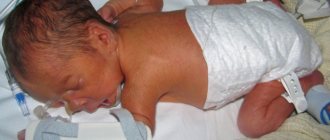High body temperature in children most often catches parents suddenly. If the child is weak and has a hot forehead, the baby asks to sit on the mother’s lap and presses against the chest, all first aid techniques are instantly removed from the head. Most often, the mother begins to fuss, call “understanding and experienced people” or frantically delve into medical reference books in search of information about the child’s health condition. Why a child has a fever for a week will be discussed in our article.
Infectious diseases

An increase in temperature up to 39 degrees or more is acceptable during the flu period, if catarrhal symptoms have not yet made themselves felt. And only on the 3rd day do specific signs appear, such as a runny nose, hoarseness, coughing, and pain in the throat. And the child also has a fever for a week due to inflammation of the urinary tract. If a baby has a fever, there is a possibility of developing childhood diseases: rubella, measles, chickenpox, diphtheria, whooping cough, etc. These diseases also have an incubation period (1–2 days), during which the main symptoms appear: redness and rashes on the skin, cough, itching, etc.
Caring for a child with a high fever
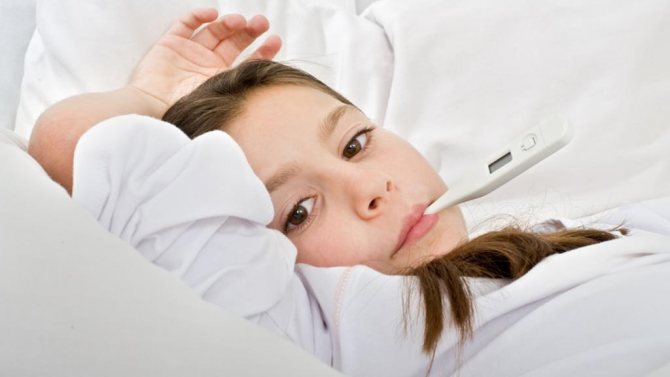
Doctors advise feeding a sick baby simple food that is easily digestible. For a while, exclude meat from the menu, especially fried meat, fatty and sweet foods, as well as canned food.
If the child’s fever lasts for a week, then give the baby plenty of warm drinks. This allows you to “wash out” harmful toxins from the body that were formed during the life of microbes. It is best to give your child warm tea with lemon, raspberries, milk with honey (if there are no allergies). Fruit drinks, compotes, and juices that include vitamin C will be extremely useful. It is allowed to give the child mineral water, decoctions of medicinal herbs, and fruit teas.
Regularly ventilate the rooms, and especially the room where the child is most often. Try to humidify the air. To do this, you can place a 3-liter jar of water in the room and hang a wet, clean towel over it. The air temperature in the room should not exceed 21 degrees.
What to do if you have seizures
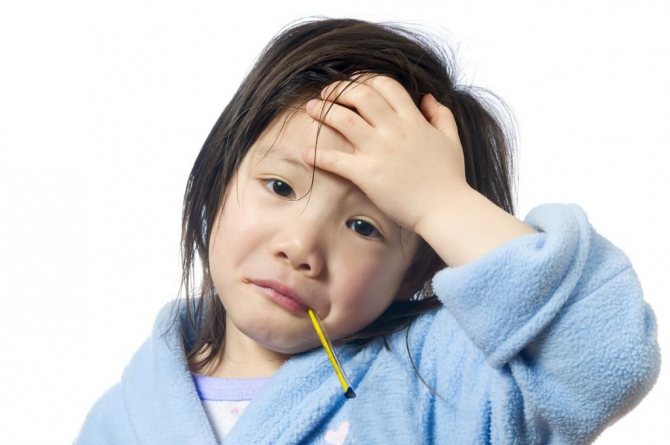
If children start having convulsions or the temperature rises to 40 degrees, immediately call an ambulance and give the child an antipyretic until it arrives.
Try putting the kids to bed or just resting. Read a fascinating book, watch colorful cartoons, play calm games. However, it is best for a child with a high temperature to sleep and gain strength.
How to dress a child in this condition
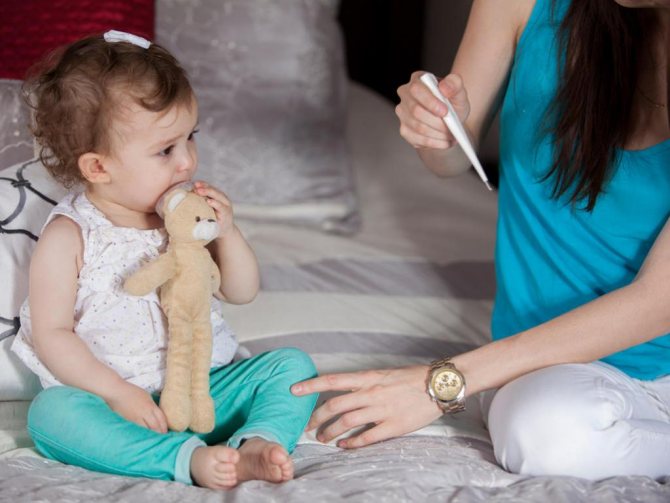
You should not dress your child “like a cabbage” or wrap him too much in warm blankets. Such actions on the part of parents can cause heat stroke if the body temperature increases to a dangerous level. Dress the patient simply and lightly, cover him with a diaper or an air blanket so that excess heat can escape freely.
There is no need to wipe children with vinegar, alcohol, or cover them with ice hot water bottles. Alcohol is quickly absorbed through delicate skin and can cause poisoning. If the child’s temperature persists for a week or more than 3–4 days after the start of treatment, the pediatrician should be called again in order to adjust the treatment.
The danger of elevated body temperature
What is the root cause of this condition? An increase in temperature in a child during the week is a response of the immune system to infection entering the body and inflammation. The blood is saturated with heat-increasing elements that are actively produced by pathogens. This stimulates the child’s body to independently produce its own pyrogens. Metabolism is significantly accelerated at the same time. This makes it easier for the immune system to fight the disease.
In most cases, a child can have a fever for a week as a secondary sign of some illness. For example, with colds in children, characteristic symptoms may appear - fever, sore throat, coughing, rhinitis. With simple colds, body heat can reach +37.8 degrees. Therefore, if the elevated temperature lasts 1-2 days, it is important to seek help from a pediatrician.
For what reasons, not related to illness, can a temperature of 37 last a week?
Vaccinations
A typical case is a side effect after vaccination. The pediatrician should warn that there may be:
- From 37.4 to 37.7℃ 5-14 days after the use of live vaccines against measles, mumps, rubella . You may already forget about the vaccination and not associate the appearance of the temperature with it. The fever most often lasts 1-2 days, but can last up to a week.
- At a level of 37.5 with the introduction of DTP , sometimes up to 38.5℃. Usually in the first couple of days, but in rare cases the child can last 5 days or even a week. It depends on the individual characteristics of the organism.
- 37-38 when inactivated polio vaccine is given . Usually 2-3 days, but in some children it can last up to 1-2 weeks.
- Up to 37.5 even a few months after anti-tuberculosis BCG . In this case, the injection site becomes inflamed. An ulcer may even appear. You definitely need to see a doctor.

After vaccination, on the recommendation of a doctor, antipyretics such as Paracetamol and Ibuprofen are given. But not after 38.5℃, as with a cold, but from 37.4. Pediatricians believe that heat for developing immunity after vaccination is not as useful as for combating active viruses during ARVI. If you are prone to seizures, then knock it down starting at 37.3℃.
Be careful with Paracetamol dosages. This medicine is a weak hepatotoxin, that is, a substance that causes liver damage in high concentrations.
At 37.7, you can do a rubdown with slightly warm water or a weak solution of vinegar (but not vodka!). And after that, let the child dry without wrapping him up or putting on warm clothes.
Allergy
A fever above 38 may be a manifestation of an allergic reaction. In this case, the doctor should prescribe an antihistamine in advance.
Teething
There are also events that will not escape anyone. With them, the temperature of 37 in some cases lasts a week. This is teething.
- The appearance of baby teeth occurs at 3-9 months. It is usually combined with profuse salivation, clear nasal discharge, increased excitability, swelling and redness of the gums, and attempts to chew on everything that is within reach. Ointments for gum pain relief and special teething toys that cool the mucous membrane will help.
- Indigenous ones begin to grow at 5-7 years. The temperature of 37 during the eruption of the first and second molars with four peaks usually lasts 1-2 days, but sometimes up to a week. More than three days - it’s better to go to the dentist, there are difficult cases. Cooling ointments Cholisal, Dentinox, Kalgel, Mundizal, Kamistad will ease the condition. But do not use them without medical advice - there are contraindications.

How to bring down a child's fever

It is believed that if a child has a fever for 37 weeks, it is more dangerous than a fever in an adult. At a temperature of 39 degrees in children, the likelihood of developing seizures and other serious complications increases. If the temperature rises rapidly up to 39 degrees, you should immediately call a pediatrician who will determine the cause of the fever. If the temperature reaches 39.1–39.2 degrees and does not stop rising, then you need to call an ambulance.
In order to avoid the development of various pathologies against the background of prolonged fever, it is necessary to prevent a subsequent increase in body temperature. Before the doctor arrives, you need to give your child an antipyretic medicine. As such, it is better to use children's Paracetamol or Panadol, which can be purchased in the form of tablets, suppositories and syrup.
The doctor needs to describe in detail what preceded the baby’s fever, tell what medications you gave before the doctor arrived. The doctor will ask about previous illnesses, surgical interventions, allergic reactions and injuries. In addition, it is important to talk about whether the child had contact with animals, whether he swam in the pool, what he ate, and where exactly he walked.
What is the normal temperature in children?
The normal temperature for children under one year of age is in the range from 36.2 to 37.4 degrees. Moreover, such values are observed in babies mainly during the first 3-4 months, and with each subsequent month the value normalizes and reaches 37 degrees. In children over 1 year old, thermometer readings vary from 36.4 to 37 degrees. If a baby has a temperature of 38 for more than 7 days, this means that the baby is developing a serious illness.

Many mothers of infants immediately begin to panic if their baby suddenly has a temperature above 36.6 degrees. With this phenomenon, there is no need to raise the alarm, especially if the baby does not look sick. Most often, an increase in temperature in children is provoked by overheating. Pediatricians say that it is more difficult for children to tolerate overheating of the body than overheating. In order to avoid overheating of the body, it is enough just to provide comfortable conditions in the room, and also dress the baby exclusively according to the weather.
It is important to know! If a baby under 1 year of age does not have a temperature above 38 degrees for a long time, then the right decision is to see a doctor. Similarly, you should consult a specialist if, in children over one year old, the thermometer shows a value above 39 degrees for a long time, and the child complains of symptoms of body malaise.
What to do if the high temperature cannot be brought down?
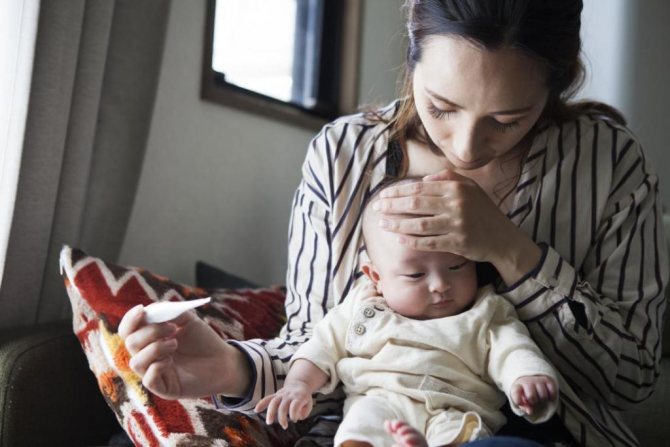
If the temperature of 39 degrees cannot be brought down, and it persists for several days, then this may indicate the development of pathologies (for example, pneumonia worsens, the educational process begins, etc.). This can be caused by an incorrect diagnosis or ineffective drug therapy. For example, in the case of a bacterial infection, an antibiotic may be prescribed incorrectly. In this case, you should immediately contact your family doctor or pediatrician. If a child has a high fever without symptoms for a week, then you should definitely call an ambulance.
Features of assistance
If the baby has a high fever for more than 7 days, which should not be allowed, then it is necessary to inform a specialist about this in a timely manner. At home, parents can do the following:
- Providing bed rest. The baby should be calm, because this is how it is possible to reduce the fever and speed up the healing process.
- The next way to reduce the fever is to regularly drink the baby. For sealing, it is recommended to use Regidron, as well as homemade drink options: juices, compotes, jelly. This method of reducing fever helps prevent dehydration, which is very important for symptoms of hyperthermia, vomiting, and diarrhea.
- Ensure comfortable conditions in the room. If hyperthermia lasts for two weeks, then it is necessary to approach the treatment of the toddler with all rigor. Self-medication with antibiotics at home is strictly prohibited, even if parents are absolutely sure of their need.
If parents really want to cure their baby and understand the causes of the developing illness, then they should promptly seek the help of a specialist. Self-medication has never brought positive results.
How long can a high temperature last?
With ARVI or influenza, a temperature of 39 degrees can remain for 2-3 days. But the presence of a bacterial infection and the development of similar complications in the form of pneumonia, otitis, sinusitis and tonsillitis, high fever can remain for a long period, for example, for 7 days.
The duration of fever directly depends on the patient’s immunity. If you are in good health, even in the case of a viral infection, your temperature will return to normal faster. Therefore, a high temperature can persist for a longer period in a small child as an immune defense.
Low-grade fever and accompanying symptoms
The causes of low-grade fever can be various diseases and they can be found out even before the doctor arrives based on certain symptoms. So, the temperature is 37 and...
• diarrhea. Such symptoms may indicate the presence of helminthic infestation or intestinal infection; • runny nose. There is a possibility of developing a cold or allergy; • abdominal pain. Symptoms of diseases such as measles, food poisoning, whooping cough, acute respiratory infections, appendicitis; • cough. Symptoms of the initial stage of bronchitis, colds, pneumonia, chronic tonsillitis, tuberculosis; • headache. Such symptoms are usually present with influenza, sinusitis, ARVI, thermoneurosis, intoxication, meningitis; • lethargy. Symptoms of the onset of an infectious disease, oncology, helminthic infestation; • hoarseness of voice. Symptoms are typical of flu, tonsillitis, laryngitis, diphtheria, • asthma, pneumonia.
Sometimes a temperature of 37°C can persist in children even after taking a course of antibiotics. At first glance, the child became active after the illness, he developed an appetite, and began to play with toys with interest. But after measuring the body temperature, that hated figure of 37°C appears on the thermometer again. What to do in such a situation? The first thing to do is to show the child to a doctor who will conduct a control examination. And if no pathological changes are detected, then no additional treatment is required.
If the temperature is accompanied by a cough, runny nose, and the child again becomes lethargic, then, most likely, there will be a suspicion of a relapse or a new infection. After the examination, the doctor himself will develop a treatment regimen and prescribe new medications.
Age-related physiology and temperature 37°C
Age-related physiology can affect body temperature. • in newborns, the norm is 37°C. Most often this applies to premature babies with an immature thermoregulation system. • 1 month after birth. A temperature of 37°C can persist after vaccination against viral hepatitis. • 2 months. Low-grade fever after vaccination against pneumococcal infection. • 3-4 months from birth. The temperature is kept within 37°C as a result of vaccination against diphtheria and pneumococcal infection. • 5 months from birth. If a low-grade fever is accompanied by colic, bloating, increased flatulence or constipation, this may indicate a reaction after the introduction of protein complementary foods. • 6-7 months. During this period, children usually teethe, the process of which often causes a slight increase in body temperature, which can last for a week.
"Panadol"
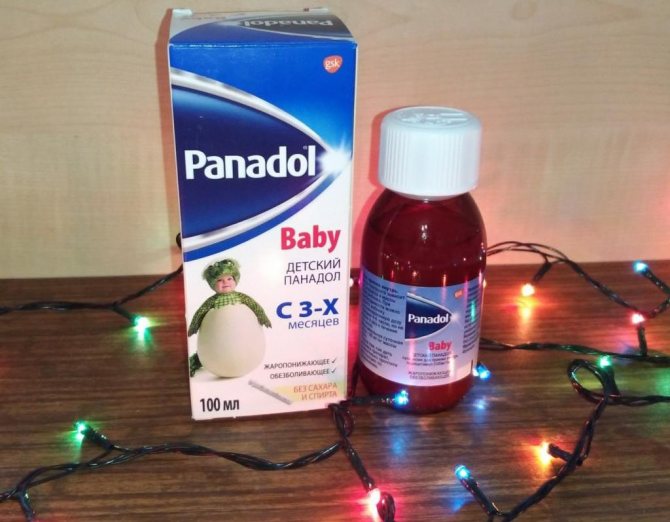
The medicine is recommended by the World Health Organization to relieve pain and reduce high fever in the following conditions:
- colds;
- influenza and childhood infectious diseases;
- pain with ordinary otitis media;
- sore throat;
- pain that occurs in a child during teething.
Pediatricians recommend Panadol if a child’s fever persists for a week after vaccination. The drug can be given to babies from three months. According to the instructions for use, children's "Panadol" quickly copes with fever and fever.
It is important to note that children's "Panadol" does not contain such components as:
- sugar;
- alcohol;
- ibuprofen;
- acetylsalicylic acid.
According to the instructions for use, children's Panadol should not be used if the child is allergic to the components of the drug.
When to get help
What should a baby's temperature be at 2 months?
A fever that persists in children for more than three days, if aggravating symptoms of the disease appear, should be a reason to call an ambulance at home. These symptoms include:
- TT is above 39.5 degrees;
- against the background of high TT, vomiting began, spasms of the muscles of the cervical spine appeared, a sharp headache that did not allow one to tilt the chin to the chest;
- elevated temperature is accompanied by severe pain in the stomach;
- barking dry cough, as a symptom of narrowing of the larynx;
- the appearance of seizures.
If the thermometer reading is below 38 degrees, you should not give your child antipyretics. The body itself tries to cope with viruses and bacteria. If an elevated temperature causes discomfort, you can reduce or get rid of its symptoms in the following ways:
- applying wet compresses to the forehead, wrists and calves;
- wiping the body with water, a weak solution of vodka or vinegar;
- It is necessary to cool the body by removing excess clothing and blankets.
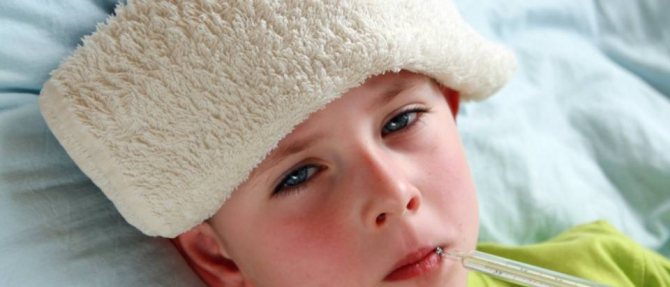
Helping a child with a high temperature
In conclusion, it should be noted that a temperature of 37 degrees in the absence of other symptoms of the disease is often observed in young children. Their body is still developing, so any foreign substance in it can cause an increase in temperature.
There are situations in which an asymptomatic increase in temperature above 37 degrees requires the use of antipyretic drugs. For example, in young children with congenital immune disorders, temperature reactions can worsen their condition and therefore require treatment. If a child has seizures during a fever, minor changes in health may cause another seizure. In such a situation, the doctor prescribes antipyretic drugs.
"Ibuprofen"
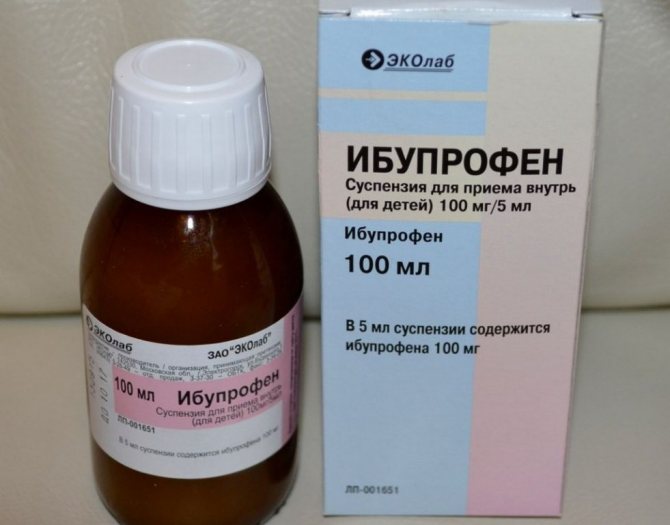
One of the safest medications that is used to lower fever in children. The product begins to act 40 minutes after taking it. The medication is prescribed according to the following regimen: no more than 2-3 times a day (no more than 20 mg per day). Doctors do not advise taking Ibuprofen if you have aspirin-induced asthma or if you have an individual intolerance to the components of the drug.
Each child is individual and tolerates an increase in temperature differently.
There are children who continue to play quietly even when the temperature rises to 39 degrees. But there are kids who, even when it rises to 37.5 degrees, sometimes even lose consciousness. For this reason, it is impossible to give any universal advice on how to behave with a child in such a situation. The most important thing is that if a child’s temperature does not subside for a week, everything should be done, without exception, so that the child’s body can “dump” excess heat. This is done in two ways:
- give plenty of fluids so that you have something to sweat with;
- provide a flow of fresh air into the room (optimally 16–18 degrees).
It makes sense to reduce the temperature with medications in the following conditions:
- Poor temperature tolerance.
- There are concomitant diseases of the nervous system.
- Body temperature is above 39 degrees.
Until the end of the 19th century, the opinion that high temperature (fever) healed was held by almost all doctors in the world without exception. However, when aspirin was invented in 1897, its antipyretic properties were advertised too hostilely and over 100 years of history, a fear of high fever developed. Meanwhile, doctors have discovered that temperature reduces the duration of the disease and reduces the likelihood of developing all kinds of pathologies. Heat reduces the negative effects of infection, which can be contagious to surrounding people. In addition, high temperature rids the body of toxins. Thus, you need to deal with fever wisely - without risking the child’s health in any way.
Preventive measures
Even if, after examination, no pathological changes are revealed in the baby, and the doctor insists that this indicator is normal for your child, you should not remove the issue of low-grade fever in your child from the agenda.
You need to understand that such a temperature over a long period of time can cause harm to the child. Therefore, you must do everything in your power to stabilize the situation. It largely depends on parents: • timely treatment of any disease, • limiting children from stressful situations, • maintaining the correct daily and sleep schedule. • hardening procedures, • child's attendance at sports clubs, • frequent walks and sunbathing. The above preventive measures will help the child’s body strengthen the immune system and stabilize the process of thermoregulation. Correct adherence to all recommendations will allow parents to quickly cope with the problem, bring the child’s body back to normal and overcome low-grade fever.




